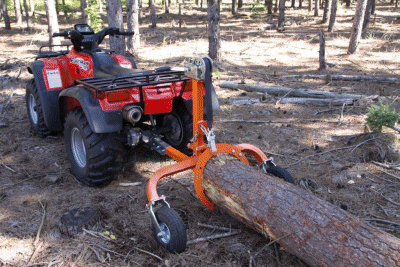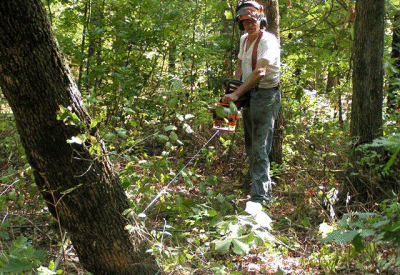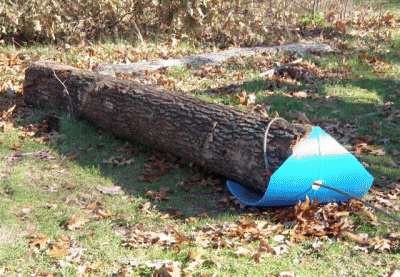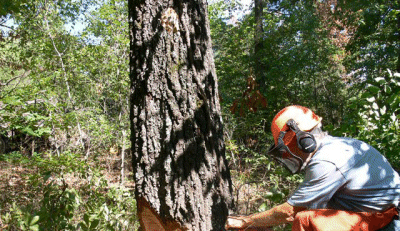Green Horizons
Volume 17, Number 1Spring 2013
By Dave Boyt, Pottershop Hollow Tree Farm manager
 |
| A four-wheel drive ATV can skid firewood and small sawlogs, with the assistance of a log arch. Filling the tires with fluid gives the ATV more traction and stability. The arch bears some of the weight of the log, and lifts the front of the log off the ground. |
Hopefully, your timber harvests are carefully thought out and planned, and the loggers who work with you show care and respect for the land. On a smaller scale, you may have harvested some firewood or logs for a small sawmill, using an ATV, farm tractor or pickup truck. It is easy to assume that, because you are only taking smaller logs, you won't risk damaging your woodlot. The potential to improve or damage your woods, however, is still there.
 |
| Even an old 8N Ford tractor can be an effective logging machine when fitted with a PTO-powered winch. It isnít fast, but it is inexpensive, and it gets the job done. |
Low impact logging hinges on having the proper tools and knowing how to use them. There are a number of tools that make woodlot management and extraction of sawlogs and firewood on a small scale safe and practical. Logging attachments for ATVs and small tractors allow you to move logs out of tight spots with barely a scratch to the soil. This article will discuss some of the techniques for using chain saws, log arches and winches.
Chainsaws
 |
| A chainsaw-powered winch is a safe, effective way to bring down a hung tree. Directional felling is so accurate I had to stage this photo, since I rarely have this problem. |
Chainsaws have the capability to cut through flesh and bone far more easily than through wood. Even with chain brakes, they can cause serious injury before you have time to react. According to the U.S. Consumer Products Safety Commission, there were over 28,500 chain saw injuries in 1999. The average injury required 110 stitches, and the average medical cost (for the year 2000) was estimated to be over $12,000 - amounting to roughly $350 million. A large number of these are from kickback, where the tip of the bar climbs up out of the cut pivoting the saw toward the operator. Even if you avoid cutting with the tip, it can contact a log by accident and kick the saw back. Take a cue from the pros - get yourself some steel toe boots, chainsaw chaps, and a logger's helmet, and wear them when you use a saw. Chaps have fibers that will stop a chain before it can cut into you. The logger's helmet combines a fine mesh screen for face protection, hearing protection, and a hard hat. Finally get training. The Game of Logging is excellent, and has both professional and landowner programs. If there isn't a landowner's program in your area, take the professional training.
Tractors and ATVs
Again safety is the main concern when extracting logs with small equipment. The conventional wisdom is that it takes big iron to move logs. Can your tractor or ATV do with finesse what a ten-ton skidder does with brute force? The most important thing is to understand the limitations of your equipment. Most ATVs are not designed for serious pulling. They lack rollover protection, and the frame, clutch, and transmission are not built to handle the stress of pulling loads. Risk of flipping a tractor or ATV over backwards is greatest when starting out pulling a load, but it can happen if a log digs into the ground or catches on a stump. The torque from the wheels tries to lift the front end, and can flip the tractor/ATV before the operator can hit the clutch. While pulling, I've noticed that the front end of my old 8N Ford is light, and sometimes I have to steer with the brakes. This is my cue to keep a foot on the clutch and be ready for the front end to lift off the ground. Front weights and liquid-filled wheels do a lot to help the stability. The rule of thumb for ATVs is not to pull more than the weight of the machine. Four-wheel drive is necessary for ATVs and helpful on tractors.
Log-skidding arches
 |
| To persuade a tree to fall against the lean, a couple of wedges is usually all it takes. Wedges can exert tremendous force, when used correctly. |
Log-skidding arches greatly extend the usefulness of a tractor/ATV for moving logs and reduce damage to the forest. These are frames that lift the log off the ground, similar in design to propane tank haulers. Since the weight of the log is supported by the arch, a lot of stress is taken off of the tractor/ATV. There is less torque required to pull the log, so the danger of rollover is much less, and pulling the log puts less stress on the machine. My first experience with a log arch was moving a log that my old Ford couldn't budge by skidding it on the ground. I backed the arch up to the log, hitched it up, and started to pull. My first thought was, "Dang it, the grapple slipped off the log again." But when I looked back, the log was still in the arch, following along with such a light load that it was barely noticeable. Since arches lift the front end of the log off the ground, there is less chance of snagging on a root or stump, and the back of the log barely scratches the soil. Norwood Sawmills has an extensive line of small-scale log skidding equipment designed for use by private landowners with small tractors and ATVs. They also offer a log arch which has a unique feature that lifts the log as it is pulled, and lowers it to the ground when backed up.
Winches
 |
| The authorís home-made skidding sled for winching logs out of tight places. The sled was made from a plastic 55 gallon barrel, and keeps the end of the log from plowing into the ground and hanging up on stumps. |
Getting logs to the tractor/ATV is often easier than getting the machine to the log. Winches allow me to get logs to trails with a minimum of disturbance to the woods. I use two winches. One is a tractor-mounted PTO winch that I bought used. It has enough power to stall the tractor engine, and will pull a 30-inch diameter oak log, if I rig it right. It is especially useful in pulling logs up out of ravines where it would be too dangerous to drive a tractor and in stands where I don't want to build additional trails. I also have a Lewis chainsaw-powered winch. The winch attaches in place of a bar in a few minutes, and has a 4,000 pound straight line pull that can be doubled with snatch blocks. In addition to skidding, it is handy for getting hung-up trees safely on the ground and pulling cars out of the ditch after snowstorms. Winching drags the log along the ground. To reduce the impact and to help keep the log from gouging into the ground or hanging up on stumps, I use a skidding sled that I cut from a plastic barrel. When the ground is dry, it hard to see where the log was skidded out.
 |
| Using the directional felling technique taught by Game of Logging, the author bores into the tree just behind the notch to make a hinge. Precision felling is the first step to low impact logging. |
With the right equipment, it is possible to pull firewood and sawlogs out of the woods with scarcely a scratch to the soil. But the equipment is only part of the equation. It takes careful planning of skid trails, and the selection of trees for harvest needs to fit into your overall management plan. Small harvesting equipment does not always mean small impact. You can still gouge out ruts and scrape logs against valuable crop trees. And even with a fair-sized farm tractor, you probably will not be able to do commercial harvests. But you will be able to harvest your own firewood and sawlogs with the potential to make some income. With the right equipment and careful operation, your woodlot operations will be the better for it.